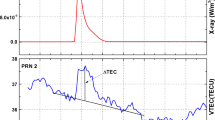Abstract
Using GPS data obtained from GPS sites located on the sunlit hemisphere during the flare on July 14, 2000, the ionospheric response to the flare was analyzed. A kind of tiny correlative ionospheric fluctuations were revealed from the temporal total electron content (TEC) curves derived from GPS measurements, and the values of this kind of disturbances are about 1015m−2. A comparative analysis of these disturbances and soft X-ray flux detected at GOES satellite during the flare is done. It is found that this kind of disturbances revealed in the temporal TEC curves did occur in a very large area of sunlit ionosphere and its behavior is mainly controlled by the characteristics of the flare’s extra radiation. Because the similar fluctuations are not found in the curve of soft X-ray flux, it is concluded that the flare extra radiation in EUV band should have corresponding fluctuations and it is the fluctuations that cause the TEC disturbances. The height, where the disturbances occur, should be in the F region.
Similar content being viewed by others
References
Davis, K., Ionospheric Radio, London: Peter Peregrinus, 1990.
Mitra, A. P., Ionospheric Effect of Solar Flares, Norwell, Mass. D. Reidel, 1974.
Taylor, G. N., Watkins, C. O., Ionospheric electron concentration enhancement during a flare, Nature, 1970, 228: 653.
Mendillo, M., Klobuchar, J. A., Fritz, R. B. et al., Behavior of the ionospheric F region during the great solar flare of August 7, 1972, J. Geophys. Res., 1974, 79(4): 665.
Arnoldy, R. L., Kane, S. R., Winckler, J. R., Energetic solar flare X-ray observed by satellite and their correlation with solar radio and energetic particle emission, Astrophys. J., 1968, 151: 711.
Matsoukas, D. A., Papagiannis, M. D. Aarons, J. et al., Correlation of solar radio bursts and sudden increases of the total electron content (SITEC) of the ionosphere, J. Atmos. Terr. Phys., 1972, 34: 1275.
Zhang Donghe, Xiao Zuo, Study of the ionospheric TEC using GPS during the large solar flare burst on Nov. 6, 1997, Chinese Science Bulletin, 2000, 45(19): 1749.
Zhang Donghe, Xiao Zuo, Chang Qing, Correlation of flare’s location on solar disc and the sudden increase of total electron content, Chinese Science Bulletin, 2002, 47(1): 82.
Zhang, D. H., Igarashi, K., Xiao, Z. et al., Observation of large scale travelling ionospheric disturbances based on GPS network, Chinese Journal of Geophysics, 2002, 45: accepted.
Mannucci, B. D., Wilson, D. N., Yuan, C. H. et al., A global mapping technique for GPS-derived ionospheric total electron content measurements, Radio Sci., 1998, 33(3): 565.
Cheng, C. C., Vanderveen, K., Orwig, L. E. et al., Temporal correlations between impulsive ultraviolet and hard X-ray bursts in solar flares observed with high time resolution, Astrophys. J, 1988, 330: 480.
Zhao Renyang, Jin Shengzhen, Fu Qijun, Solar Microwave Radio Burst, Beijing: Science Press, 1997.
Author information
Authors and Affiliations
About this article
Cite this article
Zhang, D., Xiao, Z. Correlative ionospheric disturbances in the sunlit hemisphere during the flare on July 14, 2000. Chin. Sci. Bull. 47, 975–977 (2002). https://doi.org/10.1007/BF02907563
Received:
Accepted:
Issue Date:
DOI: https://doi.org/10.1007/BF02907563




